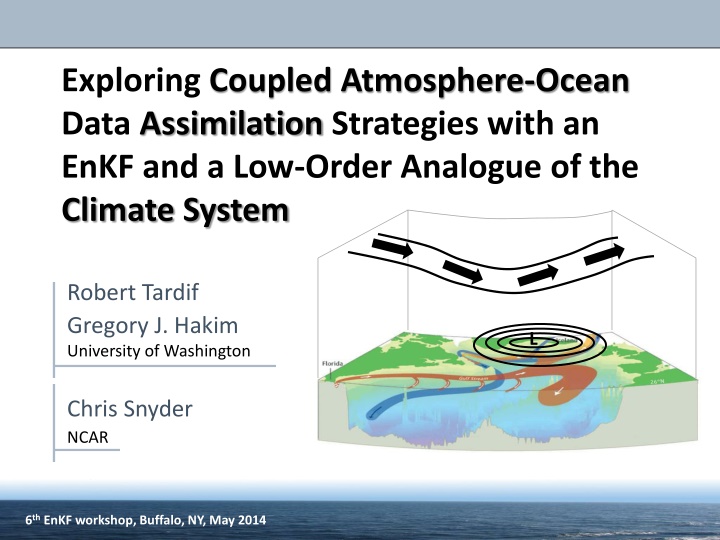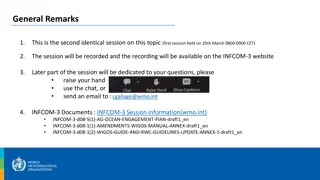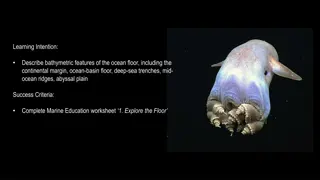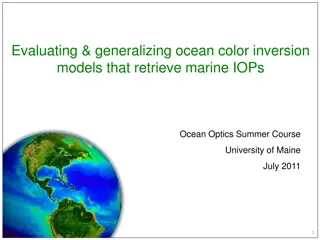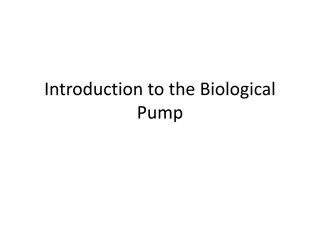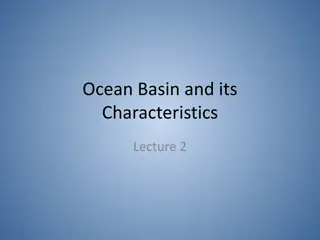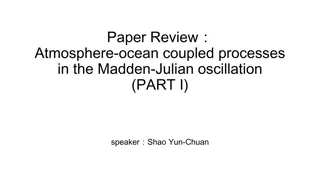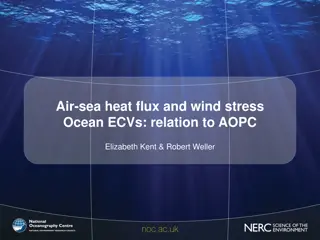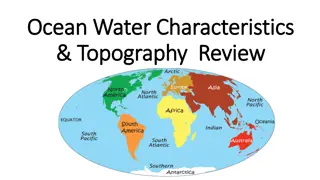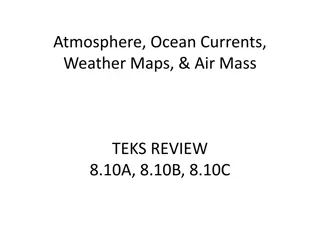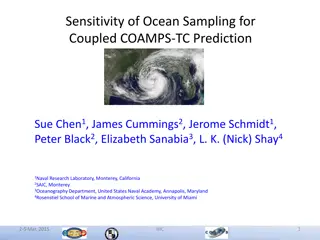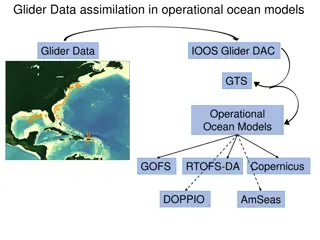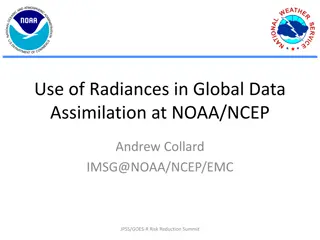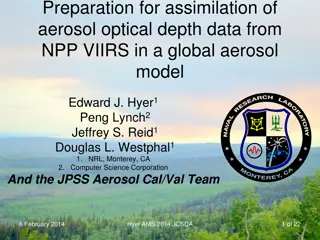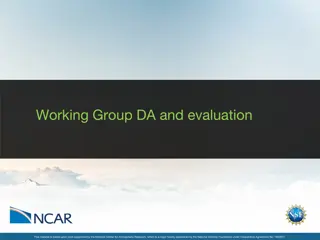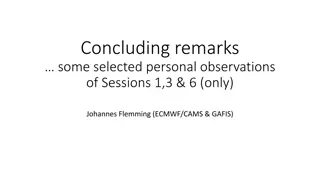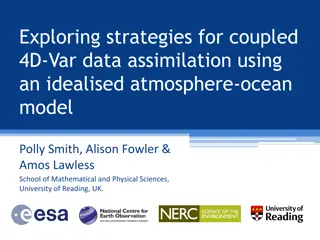Exploring Coupled Atmosphere-Ocean Data Assimilation Strategies with EnKF
This study explores data assimilation strategies for coupled atmosphere-ocean systems using an Ensemble Kalman Filter (EnKF) and a low-order analogue of the climate system. Motivated by the growing interest in near-term climate predictions, the challenges of interacting slow and fast components of the climate system are addressed. Various data assimilation approaches, challenges, and strategies are discussed, including the assimilation of time-averaged observations and the use of Kalman filtering for linear updates. The approach is tested using a low-order analogue of the North Atlantic climate system.
Download Presentation

Please find below an Image/Link to download the presentation.
The content on the website is provided AS IS for your information and personal use only. It may not be sold, licensed, or shared on other websites without obtaining consent from the author.If you encounter any issues during the download, it is possible that the publisher has removed the file from their server.
You are allowed to download the files provided on this website for personal or commercial use, subject to the condition that they are used lawfully. All files are the property of their respective owners.
The content on the website is provided AS IS for your information and personal use only. It may not be sold, licensed, or shared on other websites without obtaining consent from the author.
E N D
Presentation Transcript
Exploring Coupled Atmosphere-Ocean Data Assimilation Strategies with an EnKF and a Low-Order Analogue of the Climate System Robert Tardif Gregory J. Hakim University of Washington L Chris Snyder NCAR 6th EnKF workshop, Buffalo, NY, May 2014
Motivation Growing interest in near-term (interannual to interdecadal) climate predictions (Meehl et al. 2009, 2013) o Partly an initial-value problem: uninitialized forecasts: skill limited to large scale externally forced climate variability (Sakaguchi et al. 2012) o Requires coherent initialization of coupled low-frequencyatmosphere & ocean Unclear how to initialize the coupled climate system Various strategies considered: 1. Forcing ocean model with atmospheric reanalyses: no ocean DA 2. Data assimilation (DA) performed independently in atmosphere & ocean (i.e. combine independent atmospheric & oceanic reanalysis products) 3. Weakly coupled initialization: DA done separately in atmosphere & ocean but use fully coupled model to carry information forward 4. Fully coupled DA: w/ cross-media covariances, still in infancy (Zhang et al. 2007, 2010) (simple) (comprehensive) 6th EnKF workshop, Buffalo, NY, May 2014 2
Challenges Context: Interacting slow (ocean) & fast (atmosphere) components of the climate system Challenges: o Slow has the memory but fewer observations than in fast Q1: Possible to initialize poorly observed or unobserved ocean? o Coherence between initial conditions of slow & fast relies on cross-media covariances What do these look like? Q2: How to reliably estimate? Fast component is noisy o Practical considerations o Q3: Can fully coupled DA be done at reasonable cost? 6th EnKF workshop, Buffalo, NY, May 2014 3
DA strategies 1) Assimilation of time-averaged observations Averaging over the noise: more robust estimation of cross-media covariances? Cross-media covariances: : obs. of fast -> noisy : state vector, including slow variables Fast noise contaminates K 2) No-cycling as cost-effective alternative? Background ensemble from random draws of model states from long deterministic coupled model simulation 6th EnKF workshop, Buffalo, NY, May 2014 4
DA strategies Time-averaged assimilation Time averaging & Kalman-filter-update operators linear and commute Time-mean: Deviations: just update time-mean (Dirren & Hakim, GRL 2005; Huntley & Hakim, Clim. Dyn., 2010) 6th EnKF workshop, Buffalo, NY, May 2014 5
Approach Explored using low-order analogue of coupled North Atlantic climate system o Analyses of Atlantic meridional overtuning ciculation (AMOC) as canonical problem Key component in decadal/centennial climate variability & predictability Not well observed (i.e. important challenge for coupled DA) 1. Low-order coupled atmosphere-ocean model Cheap to run: allows multiple realizations over the attractor 2. Promising concepts tested using data from a comprehensive Earth System Model (i.e. CCSM4) To assess robustness 6th EnKF workshop, Buffalo, NY, May 2014 6
Low-order model From Roebber (1995) Features: Lorenz (1984, 1990) wave mean-flow model: fast chaotic atmosphere Stommel (1961) 3-box model of overturning ocean: low-frequency AMOC variability (i.e. no wind-driven gyre) Coupling: upper ocean temperature affects mean flow & eddies (ocean -> atmosphere) hydrological cycle affects upper ocean salinity (atmosphere -> ocean) State vector: 10 variables! 6th EnKF workshop, Buffalo, NY, May 2014 7
Model variability Atmosphere: Zonal circulation Atmosphere: chaotic; Characteristic time scale (eddy damping) ~ 5 days Ocean: AMOC Ocean: Mainly centennial/millennial variability; weaker decadal variability 6th EnKF workshop, Buffalo, NY, May 2014 8
Atmosphereocean covariability Role of atmospheric observations in coupled DA Correlations with AMOC vs averaging time X Y Z year day Increase in covariability w.r.t. AMOC for annual & longer scales Eddy energy (=X2+Y2) has more information that state variables (atmosphere -> ocean coupling through hydrologic cycle) 6th EnKF workshop, Buffalo, NY, May 2014 9
DA experiments EnKF w/ perturbed obs. & inflation for calibrated ensembles Perfect model framework: (obs. from truth w/ Gaussian noise added) Obs. error stats: large SNR (to mimmick reliable modern obs). 100-member ensemble Compared: o dailyDA (availability of instantaneous observations) o time-averaged DA (annual cycling) o Data denial: from well-observed ocean (except AMOC) to not observed at all (atmospheric obs. only) o Cyclingvs. no-cycling 6th EnKF workshop, Buffalo, NY, May 2014 10
DA experiments Ensemble-mean AMOC analyses Initial ensemble populated by random draws from reference simulation Daily DA Time-average DA (annual) Time-average DA (annual) **Atmosphere only** (eddy phases vs eddy energy) 6th EnKF workshop, Buffalo, NY, May 2014 11
DA experiments Skill over 100 randomly chosen 50-yr DA periods Coefficient of efficiency: N ( ) 2 a i x x i = = 1 1 N i CE ( ) 2 x x i = 1 i CE = 1 : analysis error variance << climo. variance CE = 0 : no information over climatology 6th EnKF workshop, Buffalo, NY, May 2014 12
Cycling vs No-cycling Skill over 100 randomly chosen 50-yr DA periods Coefficient of efficiency: N ( ) 2 a i x x i = = 1 1 N i CE ( ) 2 x x i = 1 i CE = 1 : analysis error variance << climo. variance CE = 0 : no information over climatology No-cycling : background from random draws of coupled model states from prior long deterministic of the model o Cheaper alternative (no cycling of full coupled model ensemble) o DA based on climatological covariances (no flow-dependency ) 6th EnKF workshop, Buffalo, NY, May 2014 13
No-cycling DA w/ comprehensive with AOGCM Strategy: derive low-order analogue using CCSM4 gridded output o Coarse-grained representation of the N. Atlantic climate system, but underlying complex (i.e. realistic) dynamics o 1000-yr Last Millenium CMIP5 simulation (pre-industrial natural variability) o Low-order variables: Ocean: T & S averaged over boxes (upper subpolar & subtropical, deep ocean) Atmosphere: Strentgh of zonal flow & eddy heat flux across 40oN AMOC index: Max. value of overturning streamfunction in N. Atlantic monthly 10-yr averages 6th EnKF workshop, Buffalo, NY, May 2014 14
Covariability in CCSM4 Correlations w.r.t. AMOC vs averaging time scale Atmosphere eddy heat flux Ocean subpolar upper ocean temperature month decade 6th EnKF workshop, Buffalo, NY, May 2014 15
DA results lines: time-average DA dots: upscaled monthly analyses Analyses over the 1000 years Well-obs. ocean Atmosphere only 6th EnKF workshop, Buffalo, NY, May 2014 16
Summary & conclusions Q1: Possible to initialize poorly observed or unobserved ocean? (i.e. ocean DA vs fully coupled DA) A: Yes, with time-average DA o Frequent ocean DA slightly more effective when ocean is well-observed o Fully coupled DA of time-averaged obs. critical with poorly observed ocean Q2: How to reliably estimate cross-media covariances? A: Use time-averaging over appropriate scale o Averaging over noise in fast component = > enhanced covariability Q3: Simplified cost-effective coupled DA available? A: Yes, no-cycling DA (of time-averaged obs.) cheap & viable alternative Robustness of findings w/ simple low-order model confirmed based on experiments with data from sate-of-the-art coupled climate model (CCSM4) 6th EnKF workshop, Buffalo, NY, May 2014 17
Extra slides 6th EnKF workshop, Buffalo, NY, May 2014 18
Low-order model equations 6th EnKF workshop, Buffalo, NY, May 2014 19
Low-order model equations Ensemble Size for 95% confidence on correlation Annual Daily Atmosphere Ocean 10000 realizations for each ensemble size 6th EnKF workshop, Buffalo, NY, May 2014 20
CCSM4 eddy statistics 24-hr difference filter (Wallace et al, 1988) Eddy variance Meridional eddy heat flux 6th EnKF workshop, Buffalo, NY, May 2014 21
